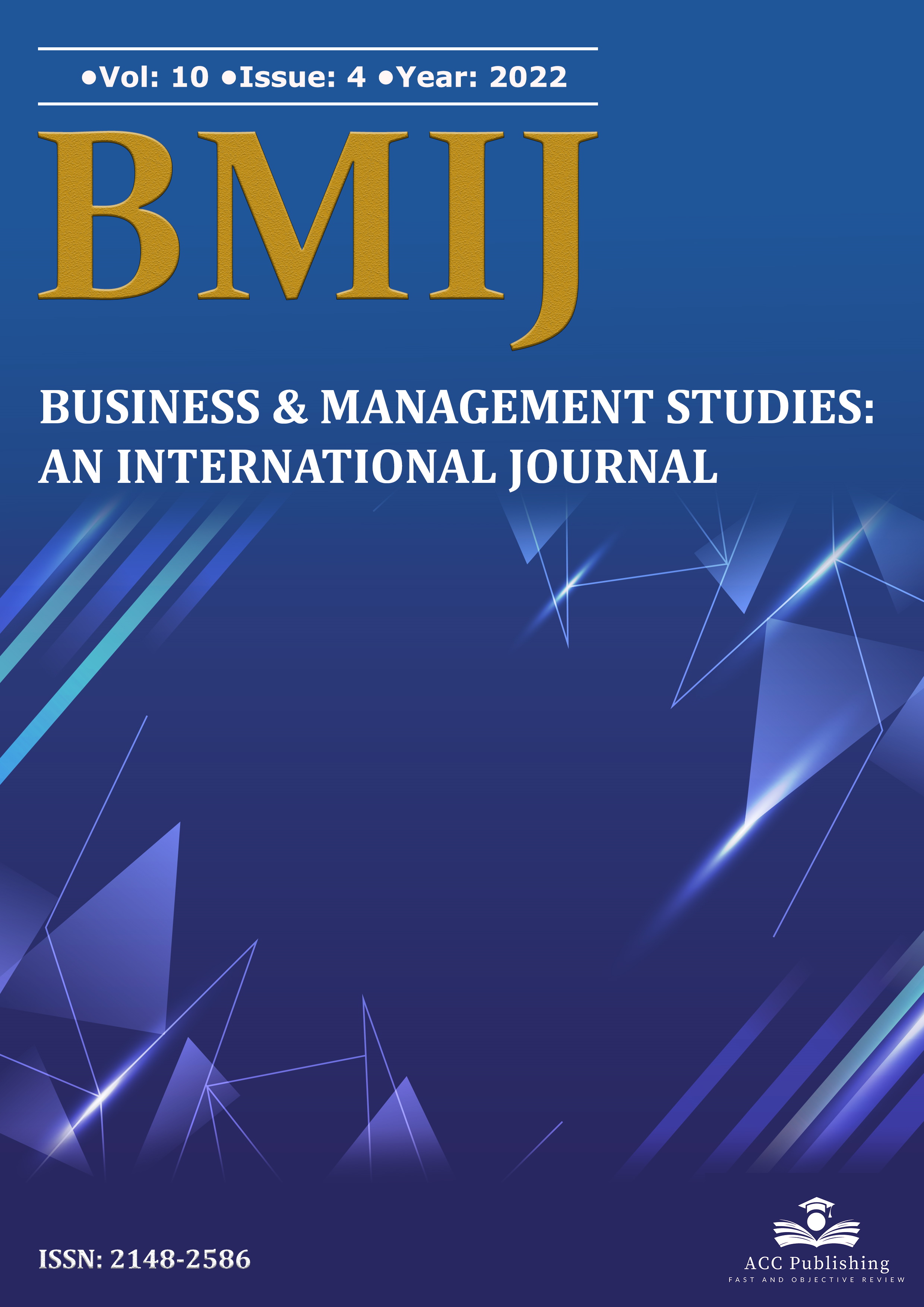Zihinsel yorumlama düzeyi tüketicilerin ürün puanı ve bireysel yorumları benimseme niyetini nasıl etkiler?

Yayınlanmış 25.12.2022
Anahtar Kelimeler
- Elektronik Ağızdan Ağıza Pazarlama, Tüketici Yorum ve Değerlendirmeleri, Zihinsel Yorumlama Düzeyi
- Ewom, Online Consumer Reviews, Mental Construal
Nasıl Atıf Yapılır
Telif Hakkı (c) 2022 Caner ÇEŞMECİ- Şebnem BURNAZ

Bu çalışma Creative Commons Attribution-NonCommercial-NoDerivatives 4.0 International License ile lisanslanmıştır.
Nasıl Atıf Yapılır
Öz
Bu çalışmanın amacı; tüketiciler açısından, çevrim içi ortamda yığın metrikler (örn., ürün puanları) ya da bireysel yorumların (örn., belirli kullanıcı yorumları) önem düzeylerinin neden ve nasıl farklılaştığını incelemektir. Bu çalışmada yığın metrikler; soyut, yığın ve kategori düzeyinde öğelerden oluşan temel oran; bireysel yorumlar ise, somut, kendine özgü ve görselleştirilebilir unsurlardan oluşan tekil vaka enformasyonu olarak yeni bir düzeyde kavramsallaştırılmıştır. Zihinsel yorumlama düzeyi, çalışmanın kuramsal altyapısını oluşturmuştur. Araştırma kapsamında, tüketicilerin yığın metrik ve bireysel yorumlara verdikleri önemi etkileyen unsurlar derinlemesine görüşmelerle tespit edilmiştir. Araştırma hipotezlerini test etmek için, bir pilot test ve deneysel çalışma tasarlanmıştır. Araştırma sonucunda; soyut zihinsel durum tetiklenen tüketicilerin yığın metrikleri; somut zihinsel durum tetiklenenlerin ise bireysel yorum ipuçlarını daha fazla benimseme niyetinde oldukları gözlemlenmiştir. Bu çalışma, elektronik ağızdan ağıza pazarlama ve zihinsel yorumlama düzeyi kuramına katkıda bulunurken, pazarlama yöneticilerine de tüketicilerin zihin durumlarına göre hangi tip ipuçlarının öne çıkarılması gerektiği konusunda içgörü sağlamaktadır.
Referanslar
- Ajzen, I. (1991). The theory of planned behavior. Organizational Behavior and Human Decision Processes, 50(2), 179–211. https://doi.org/10.1016/0749-5978(91)90020-T
- Ajzen, I. (2002). Perceived behavioral control, self-efficacy, locus of control, and the theory of planned behavior. Journal of Applied Social Psychology, 32(4), 665–683. https://doi.org/10.1111/j.1559-1816.2002.tb00236.x
- Bar-Hillel, M. (1980). The base-rate fallacy in probability judgments. Acta Psychologica, 44(3), 211–233. https://doi.org/10.1016/0001-6918(80)90046-3
- Baskin, E., Wakslak, C. J., Trope, Y., & Novemsky, N. (2014). Why Feasibility Matters More to Gift Receivers than to Givers: A Construal-Level Approach to Gift Giving. Journal of Consumer Research, 41(1), 169–182. https://doi.org/10.1086/675737
- Bernick, M. (2015, March). What Goodreads’ explosive growth means for writers and the broader economy [online], https://www.forbes.com/sites/michaelbernick/2017/03/15/ what-goodreads-explosive-growth-means-for-writers-and-the- broader-economy/#58da50751d6a [Date Accessed: September 26, 2022].
- Betsch, C., Renkewitz, F., & Haase, N. (2013). Effect of narrative reports about vaccine adverse events and bias-awareness disclaimers on vaccine decisions: A simulation of an online patient social network. Medical Decision Making, 33(1), 14–25. https://doi.org/10.1177/0272989X12452342
- Brosius, H.-B., & Bathelt, A. (1994). The utility of exemplars in persuasive communications. Communication Research, 21(1), 48–78. https://doi.org/10.1177/009365094021001004
- Cesmeci, C. (2017). The role of music in persuasion: An evolutionary approach. [Master’s dissertation, İstanbul Bilgi University].
- Changchit, C., Klaus, T., & Lonkani, R. (2022). Online Reviews: What Drives Consumers to Use Them. Journal of Computer Information Systems, 62(2), 227–236. https://doi.org/10.1080/08874417.2020.1779149
- Chatterjee, P. (2001), Online reviews: Do consumers use them?", in NA - Advances in Consumer Research Volume 28 (Eds), Mary C. Gilly and Joan Meyers-Levy, Valdosta, GA: Association for Consumer Research, pp. 129-133.
- Chevalier, J. A., & Mayzlin, D. (2006). The effect of word of mouth on sales: Online book reviews. Journal of Marketing Research, 43(3), 345–354. https://doi.org/10.1509/jmkr.43.3.345
- Chintagunta, P. K., Gopinath, S., & Venkataraman, S. (2010). The effects of online user reviews on movie box office performance: accounting for sequential rollout and aggregation across local markets. Marketing Science, 29(5), 944–957. https://doi.org/10.1287/mksc.1100.0572
- Cosmides, L., & Tooby, J. (1996). Are humans good intuitive statisticians after all? Rethinking some conclusions from the literature on judgment under uncertainty. Cognition, 58(1), 1–73. https://doi.org/10.1016/0010-0277(95)00664-8
- Daschmann, G. (2008). Exemplification and exemplars, effects of. In W. Donsbach (Ed.), The International Encyclopedia of Communication (p. wbiece050). John Wiley & Sons, Ltd. https://doi.org/10.1002/9781405186407.wbiece050
- De Langhe, B., Fernbach, P. M., & Lichtenstein, D. R. (2016). Navigating by the stars: Investigating the actual and perceived validity of online user ratings. Journal of Consumer Research, 42(6), 817–833. https://doi.org/10.1093/jcr/ucv047
- Evrard, Y., & Krebs, A. (2018). The authenticity of the museum experience in the digital age: The case of the Louvre. Journal of Cultural Economics, 42(3), 353–363. https://doi.org/10.1007/s10824-017-9309-x
- Fedewa, D., Holder, C., Teichner, W., & Wiseman, B. (2021, August). Five-star growth: Using online ratings to design better products [online], https://www.mckinsey.com/industries/consumer-packaged-goods/our-insights/five-star-growth-using-online-ratings-to-design-better-products [Date Accessed: September 26, 2022].
- Forman, C., Ghose, A., & Wiesenfeld, B. (2008). Examining the relationship between reviews and sales: The role of reviewer identity disclosure in electronic markets. Information Systems Research, 19(3), 291–313. https://doi.org/10.1287/isre.1080.0193
- Freedman, L. (2008, February) Merchant and customer perspectives on customer reviews and user-generated content [online], The E-tailing Group Inc., http://www.e-tailing.com/content/wp-content/uploads/2008/12/2008_WhitePaper_0204_4FINAL-powerreviews.pdf 2008 [Date Accessed: September 27, 2022].
- Freitas, A. L., Gollwitzer, P., & Trope, Y. (2004). The influence of abstract and concrete mindsets on anticipating and guiding others’ self-regulatory efforts. Journal of Experimental Social Psychology, 40(6), 739–752. https://doi.org/10.1016/j.jesp.2004.04.003
- Fujita, K., Trope, Y., Liberman, N., & Levin-Sagi, M. (2006). Construal levels and self-control. Journal of Personality and Social Psychology, 90(3), 351–367. https://doi.org/10.1037/0022-3514.90.3.351
- Gibson, R., & Zillmann, D. (1994). Exaggerated versus representative exemplification in news reports: Perception of issues and personal consequences. Communication Research, 21(5), 603–624. https://doi.org/10.1177/009365094021005003
- Gigerenzer, G. (1996). On narrow norms and vague heuristics: A reply to Kahneman and Tversky. Psychological Review, 103(3), 592–596. https://doi.org/10.1037/0033-295X.103.3.592
- Gilead, M., Liberman, N., & Maril, A. (2014). From mind to matter: Neural correlates of abstract and concrete mindsets. Social Cognitive and Affective Neuroscience, 9(5), 638–645. https://doi.org/10.1093/scan/nst031
- Grayson, K., & Martinec, R. (2004). Consumer perceptions of iconicity and indexicality and their influence on assessments of authentic market offerings. Journal of Consumer Research, 31(2), 296–312. https://doi.org/10.1086/422109
- Hennig-Thurau, T., Gwinner, K.P., Walsh, G., Gremler, D.D. (2004), Electronic word-of-mouth via consumer-opinion platforms: What motivates consumers to articulate themselves on the Internet?. Journal of Interactive Marketing, 18(1), 38-52. https://doi.org/10.1002/dir.10073
- Hennig-Thurau, T., Walsh, G., & Walsh, G. (2003). Electronic word-of-mouth: motives for and consequences of reading customer articulations on the internet. International Journal of Electronic Commerce, 8(2), 51–74. https://doi.org/10.1080/10864415.2003.11044293
- Ho-Dac, N. N., Carson, S. J., & Moore, W. L. (2013). The effects of positive and negative online customer reviews: Do brand strength and category maturity matter? Journal of Marketing, 77(6), 37–53. https://doi.org/10.1509/jm.11.0011
- Hoffart, J. C., Olschewski, S., & Rieskamp, J. (2019). Reaching for the star ratings: A Bayesian-inspired account of how people use consumer ratings. Journal of Economic Psychology, 72, 99–116. https://doi.org/10.1016/j.joep.2019.02.008
- Hofmann, J., Clement, M., Völckner, F., & Hennig-Thurau, T. (2017). Empirical generalizations on the impact of stars on the economic success of movies. International Journal of Research in Marketing, 34(2), 442–461. https://doi.org/10.1016/j.ijresmar.2016.08.006
- Humphreys, A., Isaac, M. S., & Wang, R. J.-H. (2021). Construal matching in online search: Applying text analysis to illuminate the consumer decision journey. Journal of Marketing Research, 58(6), 1101–1119. https://doi.org/10.1177/0022243720940693
- Kaemingk, D. (2020, October). Online reviews statistics to know in 2022 [online], https://www.qualtrics.com/blog/online-review-stats/ [Date Accessed: September 26, 2022].
- Kahneman, D., & Tversky, A. (1973). On the psychology of prediction. Psychological Review, 80(4), 237–251. https://doi.org/10.1037/h0034747
- Kahneman, D., & Tversky, A. (1996). On the reality of cognitive illusions. Psychological Review, 103(3), 582–591. https://doi.org/10.1037/0033-295X.103.3.582
- Kaleta, J. P., & Aasheim, C. (2022). Construal of Social Relationships in Online Consumer Reviews. Journal of Computer Information Systems, 1–12. https://doi.org/10.1080/08874417.2022.2054479
- Kim, M., & Kim, J. (2020). The Influence of Authenticity of Online Reviews on Trust Formation among Travelers. Journal of Travel Research, 59(5), 763–776. https://doi.org/10.1177/0047287519868307
- King, R. A., Racherla, P., & Bush, V. D. (2014). What we know and don’t know about online word-of-mouth: A review and synthesis of the literature. Journal of Interactive Marketing, 28(3), 167–183. https://doi.org/10.1016/j.intmar.2014.02.001
- Klaus, P. (2013). The case of Amazon.com: Towards a conceptual framework of online customer service experience (OCSE) using the emerging consensus technique (ECT). Journal of Services Marketing, 27(6), 443–457. https://doi.org/10.1108/JSM-02-2012-0030
- Koiso-Kanttila, N. (2005). Time, attention, authenticity and consumer benefits of the Web. Business Horizons, 48(1), 63–70. https://doi.org/10.1016/j.bushor.2004.10.004
- Kozinets, R. V. (2016). Amazonian forests and trees: Multiplicity and objectivity in studies of online consumer-generated ratings and reviews, a commentary on de Langhe, Fernbach, and Lichtenstein. Journal of Consumer Research, 42(6), 834–839. https://doi.org/10.1093/jcr/ucv090
- Lee, S., & Choeh, J. Y. (2020). Using the social influence of electronic word-of-mouth for predicting product sales: The moderating effect of review or reviewer helpfulness and product type. Sustainability, 12(19), 7952. https://doi.org/10.3390/su12197952
- Lermer, E., Streicher, B., Sachs, R., Raue, M., & Frey, D. (2015). The effect of construal level on risk-taking: Construal level and risk. European Journal of Social Psychology, 45(1), 99–109. https://doi.org/10.1002/ejsp.2067
- Li, X., Wu, C., & Mai, F. (2019). The effect of online reviews on product sales: A joint sentiment-topic analysis. Information & Management, 56(2), 172–184. https://doi.org/10.1016/j.im.2018.04.007
- Liberman, N., & Trope, Y. (2014). Traversing psychological distance. Trends in Cognitive Sciences, 18(7), 364–369. https://doi.org/10.1016/j.tics.2014.03.001
- Liberman, N., Sagristano, M. D., & Trope, Y. (2002). The effect of temporal distance on level of mental construal. Journal of Experimental Social Psychology, 38(6), 523–534. https://doi.org/10.1016/S0022-1031(02)00535-8
- Liberman, N., Trope, Y., & Wakslak, C. (2007). Construal level theory and consumer behavior. Journal of Consumer Psychology, 17(2), 113–117. https://doi.org/10.1016/S1057-7408(07)70017-7
- Lu, A. C. C., Gursoy, D., & Lu, C. Y. (2015). Authenticity perceptions, brand equity and brand choice intention: The case of ethnic restaurants. International Journal of Hospitality Management, 50, 36–45. https://doi.org/10.1016/j.ijhm.2015.07.008
- Lyon, D., & Slovic, P. (1976). Dominance of accuracy information and neglect of base rates in probability estimation. Acta Psychologica, 40(4), 287–298. https://doi.org/10.1016/0001-6918(76)90032-9
- McCrea, S. M., Wieber, F., & Myers, A. L. (2012). Construal level mind-sets moderate self- and social stereotyping. Journal of Personality and Social Psychology, 102(1), 51–68. https://doi.org/10.1037/a0026108
- Mudambi, S. M. & Schuff, D. (2010). Research note: What Makes a helpful online review? A study of customer reviews on Amazon.com. MIS Quarterly, 34(1), 185. https://doi.org/10.2307/20721420
- Naylor, R. W., Lamberton, C. P., & Norton, D. A. (2011). Seeing ourselves in others: Reviewer ambiguity, egocentric anchoring, and persuasion. Journal of Marketing Research, 48(3), 617–631. https://doi.org/10.1509/jmkr.48.3.617
- Ngarmwongnoi, C., Oliveira, J. S., AbedRabbo, M., & Mousavi, S. (2020). The implications of eWOM adoption on the customer journey. Journal of Consumer Marketing, 37(7), 749–759. https://doi.org/10.1108/JCM-10-2019-3450
- Nisbett, Richard E., and Lee Ross (1980), Human inference: Strategies and shortcomings of social judgment, Englewood Cliffs, NJ: Prentice-Hall.
- Ordabayeva, N., Cavanaugh, L. A., & Dahl, D. W. (2022). The upside of negative: Social distance in online reviews of identity-relevant brands. Journal of Marketing, 002224292210747. https://doi.org/10.1177/00222429221074704
- Ozanne, M., Liu, S. Q., & Mattila, A. S. (2019). Are attractive reviewers more persuasive? Examining the role of physical attractiveness in online reviews. Journal of Consumer Marketing, 36(6), 728–739. https://doi.org/10.1108/JCM-02-2017-2096
- Pan, Y., & Zhang, J. Q. (2011). Born unequal: A Study of the Helpfulness of User-Generated Product reviews. Journal of Retailing, 87(4), 598–612. https://doi.org/10.1016/j.jretai.2011.05.002
- Park, D.-H., & Lee, J. (2008). EWOM overload and its effect on consumer behavioral intention depending on consumer involvement. Electronic Commerce Research and Applications, 7(4), 386–398. https://doi.org/10.1016/j.elerap.2007.11.004
- Park, D.-H., Lee, J., & Han, I. (2007). The effect of on-line consumer reviews on consumer purchasing intention: The moderating role of involvement. International Journal of Electronic Commerce, 11(4), 125–148. https://doi.org/10.2753/JEC1086-4415110405
- Perloff, R.M. (2010). The Dynamics of persuasion; communication and attitudes in the 21st century. NY: Routledge.
- Peter, C., & Brosius, H.-B. (2010). Grenzen der wirksamkeit von fallbeispielen? [Limits of effectiveness of exemplars?]. Publizistik, 55, 275–288.
- Pizzi, G., Marzocchi, G. L., Orsingher, C., & Zammit, A. (2015). The temporal construal of customer satisfaction. Journal of Service Research, 18(4), 484–497. https://doi.org/10.1177/1094670515584752
- Powell, D., Yu, J., DeWolf, M., & Holyoak, K. J. (2017). the love of large numbers: A popularity bias in consumer choice. Psychological Science, 28(10), 1432–1442. https://doi.org/10.1177/0956797617711291
- Power Reviews (2020, April). Market trends snapshot – April 2020 [online], https://www.powerreviews.com/insights/impact-consumer-ratings-covid-19/ [Date Accessed: September 26, 2022].
- Power Reviews (2021). Survey: The ever-growing power of -reviews [online], https://www.powerreviews.com/insights/power-of-reviews-survey-2021/ [Date Accessed: September 26, 2022].
- Qiu, L., Pang, J., & Lim, K. H. (2012). Effects of conflicting aggregated rating on eWOM review credibility and diagnosticity: The moderating role of review valence. Decision Support Systems, 54(1), 631–643. https://doi.org/10.1016/j.dss.2012.08.020
- Racherla, P., & Friske, W. (2012). Perceived ‘usefulness’ of online consumer reviews: An exploratory investigation across three services categories. Electronic Commerce Research and Applications, 11(6), 548–559. https://doi.org/10.1016/j.elerap.2012.06.003
- Raue, M., Streicher, B., Lermer, E., & Frey, D. (2015). How far does it feel? Construal level and decisions under risk. Journal of Applied Research in Memory and Cognition, 4(3), 256–264. https://doi.org/10.1016/j.jarmac.2014.09.005
- Richins, M. L. & Root-Shaffer, T. (1988). The role of evolvement and opinion leadership in consumer word-of-mouth: An implicit model made explicit. In Micheal J. Houston (Ed.), NA - Advances in Consumer Research, Volume 15 (pp. 32-36). Provo, UT: Association for Consumer Research.
- Rynarzewska, A. I. (2019). It’s not fake, it’s biased: Insights into morality of incentivized reviewers. Journal of Consumer Marketing, 36(3), 401–409. https://doi.org/10.1108/JCM-02-2018-2570
- Saad, G. (2017). On the method of evolutionary psychology and its applicability to consumer research. Journal of Marketing Research, 54(3), 464–477. https://doi.org/10.1509/jmr.14.0645
- Sagristano, M. D., Trope, Y., & Liberman, N. (2002). Time-dependent gambling: Odds now, money later. Journal of Experimental Psychology: General, 131(3), 364–376. https://doi.org/10.1037/0096-3445.131.3.364
- Salehan, M., & Kim, D. J. (2016). Predicting the performance of online consumer reviews: A sentiment mining approach to big data analytics. Decision Support Systems, 81, 30–40. https://doi.org/10.1016/j.dss.2015.10.006
- Schuckert, M., Liu, X., & Law, R. (2016). Stars, votes, and badges: how online badges affect hotel reviewers. Journal of Travel & Tourism Marketing, 33(4), 440–452. https://doi.org/10.1080/10548408.2015.1064056
- Solomon, M. R. (1986). The missing link: Surrogate consumers in the marketing chain. Journal of Marketing, 50(4), 208–218. https://doi.org/10.1177/002224298605000406
- Spassova, G., & Lee, A. Y. (2013). Looking into the future: A Match between self-view and temporal distance. Journal of Consumer Research, 40(1), 159–171. https://doi.org/10.1086/669145
- Stillman, P. E., Lee, H., Deng, X., Unnava, H. R., Cunningham, W. A., & Fujita, K. (2017). Neurological evidence for the role of construal level in future-directed thought. Social Cognitive and Affective Neuroscience, 12(6), 937–947. https://doi.org/10.1093/scan/nsx022
- Tabachnick, B.G. and Fidell, L.S. (2001), Using multivariate statistics, Allyn & Bacon, Needham Heights, MA.
- The Nielsen Company (2015, September). Global trust in advertising: Winning strategies for an evolving media landscape. https://www.nielsen.com/wp-content/uploads/sites/3/2019/04/global-trust-in-advertising-report-sept-2015-1.pdf.
- Trope, Y., & Liberman, N. (2003). Temporal construal. Psychological Review, 110(3), 403–421. https://doi.org/10.1037/0033-295X.110.3.403
- Trope, Y., & Liberman, N. (2010). Construal-level theory of psychological distance. Psychological Review, 117(2), 440–463. https://doi.org/10.1037/a0018963
- Trope, Y., Liberman, N., & Wakslak, C. (2007). Construal levels and psychological distance: Effects on representation, prediction, evaluation, and behavior. Journal of Consumer Psychology, 17(2), 83–95. https://doi.org/10.1016/S1057-7408(07)70013-X
- Trope, Yaacov L. (2012). Construal Level Theory. In P. K. Van Lange, A. W. Kruglanski, E.T. Higgins (Eds.), Handbook of Theories of Social Psychology (pp. 118-134). Washington DC: Sage Publications.
- Vallacher, R., & Wegner, D. (1989). Levels of personal agency: individual variation in action identification. Journal of Personality and Social Psychology, 57, 660–671.
- Van Laer, T., Edson Escalas, J., Ludwig, S., & van den Hende, E. A. (2019). What happens in vegas stays on tripadvisor? A theory and technique to understand narrativity in consumer reviews. Journal of Consumer Research, ucy067. https://doi.org/10.1093/jcr/ucy067
- Varnali, K., & Cesmeci, C. (2022). Customer responses to service failures on social media. Journal of Services Marketing, 36(5), 691–709. https://doi.org/10.1108/JSM-11-2020-0484
- Wakefield, L. T., & Wakefield, R. L. (2018). Anxiety and ephemeral social media use in negative ewom creation. Journal of Interactive Marketing, 41, 44–59. https://doi.org/10.1016/j.intmar.2017.09.005
- Wakslak, C., & Trope, Y. (2009). The effect of construal level on subjective probability estimates. Psychological Science, 20(1), 52–58. https://doi.org/10.1111/j.1467-9280.2008.02250.x
- Wang, J., Hong, J., & Zhou, R. (2018). How long did i wait? The effect of construal levels on consumers’ wait duration judgments. Journal of Consumer Research, 45(1), 169–184. https://doi.org/10.1093/jcr/ucx117
- Welsh, M. B., & Navarro, D. J. (2012). Seeing is believing: Priors, trust, and base rate neglect. Organizational Behavior and Human Decision Processes, 119(1), 1–14. https://doi.org/10.1016/j.obhdp.2012.04.001
- Yan, D., & Sengupta, J. (2013). The influence of base rate and case information on health-risk perceptions: A unified model of self-positivity and self-negativity. Journal of Consumer Research, 39(5), 931–946. https://doi.org/10.1086/666596
- Yin, D., Bond, S. D., & Zhang, H. (2014). Anxious or angry? Effects of discrete emotions on the perceived helpfulness of online reviews. MIS Quarterly, 38(2), 539–560. https://doi.org/10.25300/MISQ/2014/38.2.10
- Zheng, L. (2021). The classification of online consumer reviews: A systematic literature review and integrative framework. Journal of Business Research, 135, 226–251. https://doi.org/10.1016/j.jbusres.2021.06.038
- Zhu, L., Yin, G., & He, W. (2014). Is this opinion leader’s review useful? Peripheral cues for online review helpfulness. Journal of Electronic Commerce Research, 15(4), 367-280.
- Ziegele, M., & Weber, M. (2015). Example, please! Comparing the effects of single customer reviews and aggregate review scores on online shoppers’ product evaluations: Example, please! Journal of Consumer Behaviour, 14(2), 103–114. https://doi.org/10.1002/cb.1503



